ALMA
Latest
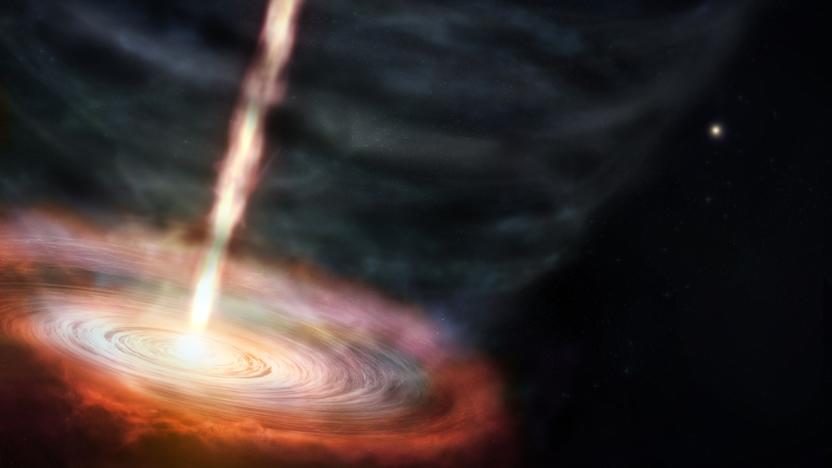
What an 'oddball' star in the Cygnus cluster can teach us about how masers are made
Researchers with the National Radio Astronomy Observatory may have uncovered a significant insight into how masers (nature's lasers) are formed while conducting a routine study of the "oddball" star MWC 349A.
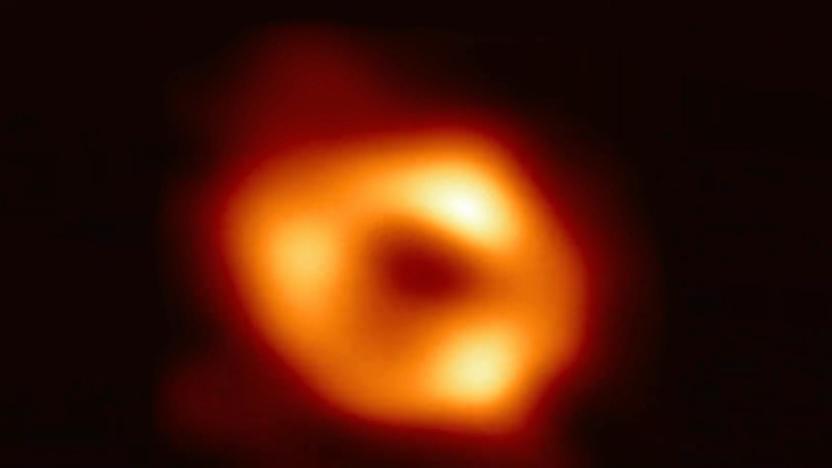
Scientists reveal first image of the black hole in the center of our galaxy
Scientists have captured the first image of the black hole at the center of the Milky Way.
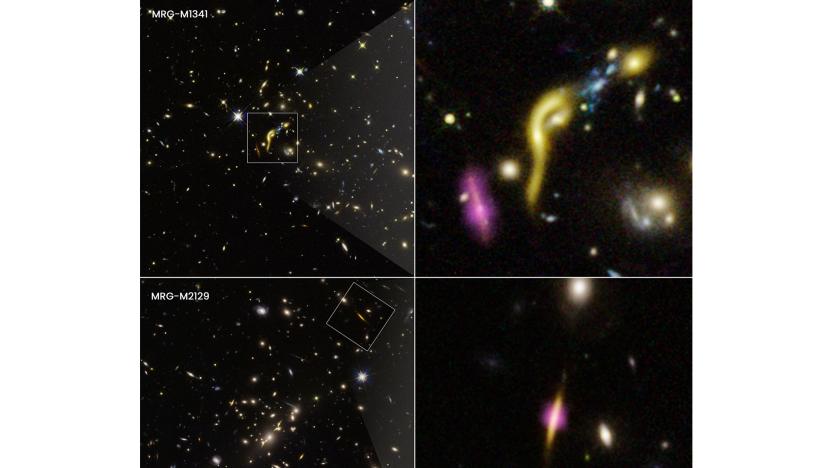
Hubble telescope helps find six 'dead' galaxies from the early universe
The Hubble telescope and ALMA have found six 'dead' early galaxies that stopped forming stars unusually quickly.

Astronomers spot possible moon-forming region for the first time
A group of astronomers has discovered what's believed to be a region with exomoons-in-the-making for the first time.

This is the first real picture of a black hole
Yes, it happened. After years of relying on computer-generated imagery, scientists using the Event Horizon Telescope have captured the first real image of a black hole. The snapshot of the supermassive black hole in the Messier 87 galaxy (about 55 million light years away) shows the "shadow" created as the event horizon bends and sucks in light. It also confirms that the black hole is truly huge, with a mass 6.5 billion times that of the Sun. As you might imagine, taking this picture was tricky -- it required worldwide collaboration that wasn't possible until recently.
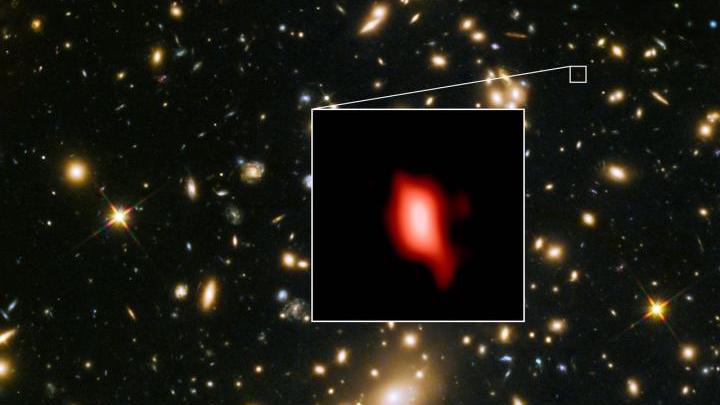
The first stars may have formed much earlier than scientists thought
After the Big Bang occurred, there was no oxygen in the early universe. Stars had to be born before oxygen could be created by fusion processes. When these stars died, the oxygen was released into the universe. Now, a research team using the ALMA telescope has found ionized oxygen in an early galaxy, MACS1149-JD1, that is dated just 500 million years after the Big Bang. This means that stars were created much, much sooner than previously thought.
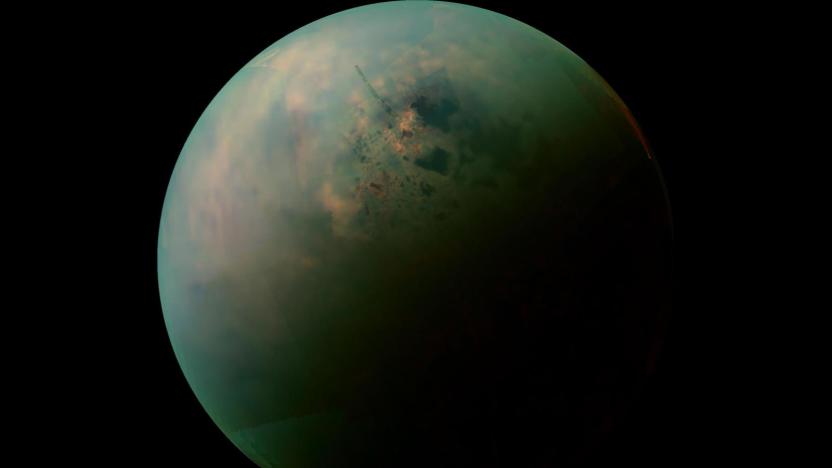
A molecule found on Saturn's moon Titan could foster life
In a new study published today in Science Advances, researchers report that they've found a complex molecule in the atmosphere of Saturn's moon Titan that could lead to the formation of life. Cell membranes are the outer barrier of most cells found on Earth and they, or structures like them, are crucial for life to form. And while Titan is quite different from our planet, it's thought that this molecule -- vinyl cyanide -- is one that could potentially form cell membranes in the Titan environment.
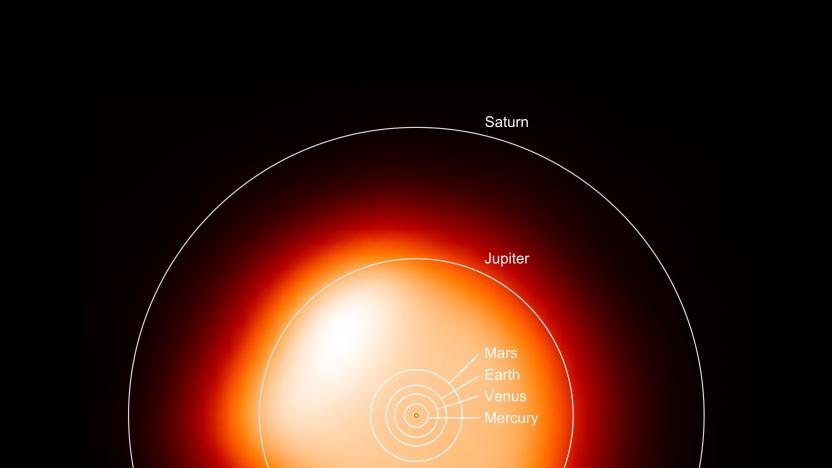
Astronomers capture best picture yet of the star in Orion’s armpit
Betelgeuse isn't just an etymological inspiration for Michael Keaton's best role, it's a colossal star forming the right shoulder in the well-known constellation Orion. Astronomers used the Atacama Large Millimeter Array (ALMA) in Northern Chile to photograph it, producing the most detailed image yet of any star besides our own sun.
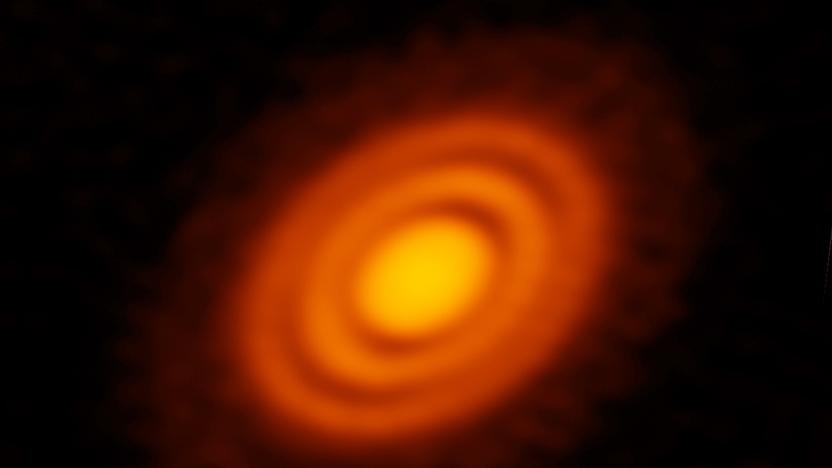
Exoplanets may have carved dusty tracks around a young star
Astronomers have spotted what they believe are two Saturn-sized planets carving "tracks" through a young star's protoplanetary disk. Although scientists have found plenty of exoplanets ranging from gas giants like Jupiter to rocky, Earth-like worlds, most orbit mature stars. However, the not-yet-fully-formed worlds imaged by the ALMA telescope array show that stars can possibly spawn planets at an earlier age than previously thought.
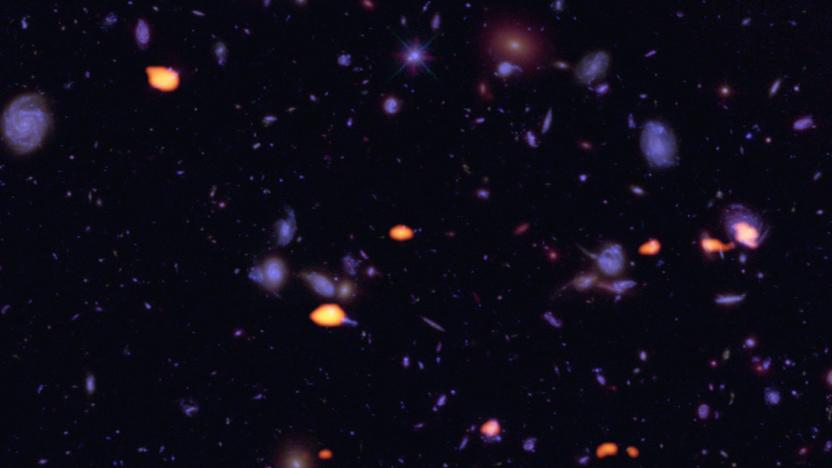
Hubble study helps explain the heyday of galaxy formation
The Hubble Space Telescope still isn't done giving up secrets of the early universe. Researchers using the Atacama Large Millimeter/submillimeter Array (ALMA) have discovered that a patch of 10 billion-year-old galaxies in Hubble's Ultra Deep Field view holds gas that helps explain the "Golden Age" of galaxy and star formation. This first completely "blind" (that is, not expecting anything) 3D millimeter wavelength search of the old universe turned up galaxies with an abundance of carbon monoxide, a hint that they were rich in the molecular gas key to creating stars.

Here's your clearest view yet of star formation in the early universe
Spotting anything at the edge of the known universe is difficult, but scientists have just managed to get a surprisingly sharp view. They've used the ALMA telescope array's imaging and spectral info to visualize a galaxy about 11.4 billion light years away (2.4 billion years after the Big Bang) in unprecedented detail -- enough to see clumps of stars that were still forming at the time. The key was taking advantage of a special gravitational lensing effect, an Einstein ring, where Earth is in perfect alignment with both the target galaxy and an in-between galaxy distorting and magnifying the target's light. Researchers used modeling to correct for that distortion and see what the ancient celestial body really looked like. It's not a perfect picture (the intermediary galaxy's black hole is obscuring things), but it's still humanity's best peek yet at what was happening well before our planet even existed. [Image credit: ALMA (NRAO/ESO/NAOJ)/Y. Tamura (The University of Tokyo)/Mark Swinbank (Durham University)]

The Big Picture: giving birth to a solar system
While one hot topic regarding outer space lately is a work of science fiction, here's some fact to switch that up -- in case comets aren't really your bag. What you see above is the first result of the Alma telescope array set up in its near-final form, capturing the beginnings of a solar system that could be much like our own given enough time. HL Tauri is a star some 450 light years away that's surrounded by the dusty disc-shaped remains of star-birth, is around a million years old and already forming planets by the looks of things. As ESO reports, scientists say that this sole image will "revolutionize theories of planetary formation" because it means planets may actually, well, form, faster than previously expected. Even better? This image might give us a clearer idea of what our own solar system looked like in its early days.

F.E.A.R. Online comes to S.T.E.A.M.
As we all know, your games are incapable of being scary if they're not powered by the hatred of a forsaken child. That's why you need a jolt of F.E.A.R. Online this Halloween, an experience that is easier than ever to procure now that it's on Steam. You'll also be happy to know that the Desert Storm M4A1 DLC is currently on sale at 10% off, bringing it down from $0.99 to $0.89. This online free-to-play horror-themed shooter features both a co-op and PvP mode, the latter of which can turn players into literal beasts. F.E.A.R. also has a Soul King mode that allows players to "possess" enemy mobs in order to attack fellow players from any direction.

Aeria to publish F.E.A.R. Online
Quick, which F2P company do you think is publishing an online version of the much-loved psychological horror-thriller-first-person-shooter F.E.A.R. franchise? If you said Aeria, the firm that brought us Eden Eternal and Lime Odyssey, well, you get a gold star. Anyway, yes, Aeria is publishing F.E.A.R. Online, which appears to be a continuation of the story of Alma Wade who has served as the series' primary mystery and antagonist since the original 2005 Monolith title. Aeria's press release mentions a co-op mode and several competitive team modes, with the new title's story supposedly running parallel to that of 2009's F.E.A.R. 2: Project Origin. Though Aeria is publishing the game in the west, it is actually being developed in Korea by Inplay Interactive. You can sign up for a beta slot on the title's official website. [Source: Aeria press release]

Earth's largest telescope gets to work in Chile after 30 years of planning
Nestled within the Chilean Andes, the new Atacama Large Millimeter-submillimeter Array (ALMA) is now open for space-staring business. The biggest, most complex telescope project to date, ALMA will be able to peer into the deeper reaches of space with "unprecedented power", according to astronomer Chris Hadfield. Covering around half of the universe's light spectrum, between infrared and radio waves, the new telescope should be able to detect distant planets, black holes and other intergalactic notables. The Chilean desert's lack of humidity was a big reason for the telescope's placement, 16,400 feet above sea-level, aiding precision of the scope. But it's a global project, with the US contributing $500 million and making it the NSF's biggest investment ever. From Japan, Fujitsu's contribution to exploring the final frontier consists of 35 PRIMERGY x86 servers, tied together with a dedicated (astronomy-centric) computational unit. The supercomputer will process 512 billion telescope samples per second, which ought to be more than enough to unlock a few more secrets of the cosmos.

Alma observatory captures stars being born, reports back on universe's awkward teenage years
A baby book for our cosmos? That'd be a happy by-product of the massive insight star-gazing scientists are set to glean from Alma -- the telescope responsible for ushering in a "new golden age of astronomy." The Atacama large millimeter/submillimeter array (as it's known in long form), located 3,000 meters above sea level on a Chilean plateau, goes beyond the voyeuristic powers of current optical telescopes, delivering detailed imagery of the dense gas clouds that birth baby stars. Why is this significant? Well, using the complex 20-antenna strong array (a total of 66 are planned), astronomers from North America, Europe and Japan will get a first-hand glimpse of the gaseous mix that was our universe a few hundred million years post-Big Bang. Consider the research a time-traveling peek back into the formative years of existence. Heady stuff, yes, but the array won't have its multiple, celestial-focused eyes trained solely on star nurseries; scientists from around the globe already plan on getting an up close look at the Sagittarius A black hole. When these "Pyramids of the 21st Century" finish construction in 2013, we'll be just one step closer to viewing the limits of our cosmic fishbowl.

Alma's back in latest F.E.A.R. 2 trailer
With F.E.A.R. 2 arriving next week, we'll finally be able to turn down the lights, draw the curtains, and scare ourselves silly. Warner Bros. and Monolith have dished out a new trailer (it's rated "M," so you'll find it after the break) featuring plenty of gameplay, a fairly in-depth look at the game's story and several instances of that creepy Alma girl popping up at random times. Give it a watch and if you feel so inclined, hit up the BD link below and download the thing in HD. Those seeking out a more interactive vignette should download the recently released demo. Download the F.E.A.R. 2 launch trailer in HD (332mb)

Matthews: Ports and expansions contributed to loss of FEAR fans
Monolith's Dave Matthews, lead art designer for F.E.A.R. 2: Project Origin, says multiple expansions and console ports have likely cost the shooter franchise some fans. In an interview with CVG a comment was made to Matthews that the TimeGate developed expansions and Day 1 Studios developed console-ports of the critically acclaimed shooter could be responsible for bringing new eyes to the horror-fueled FPS. "And killed off a few," Matthews noted. Matthews primary reason for the comment based on story decisions taken once the series was out of Monolith's hands. "[TimeGate] took the story in a direction that we didn't intend ... We look at Extraction Point and Perseus Mandate as an alternate universe," Matthews told CVG. "F.E.A.R. was about Alma, F.E.A.R. 2 is about Alma, and we wanted to continue the story the way we originally intended." This time around Monolith, who gained Xbox 360 experience from the Condemned series, has committed to develop all three version of the upcoming sequel. "While there will be some slight variations between the different versions ... our main goal is to make sure the experience is synonymous across all three platforms."













